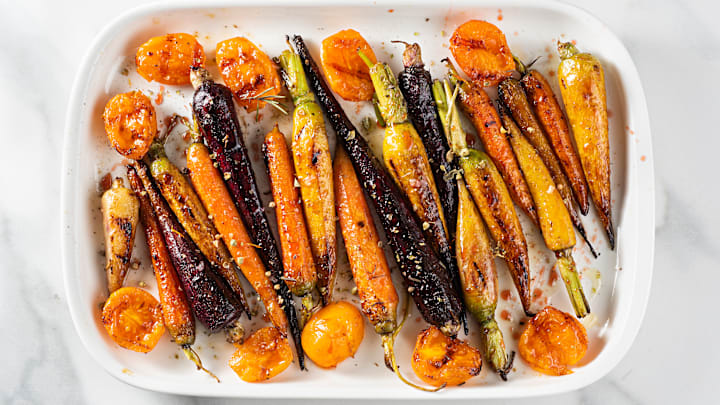Roasting is one of the simplest methods of cooking. Dry heat (usually from an oven) transforms raw ingredients into golden brown deliciousness. And while you can certainly roast proteins like beef and fish, some of the most delicious roasted recipes are vegetarian-friendly.
Here, courtesy of Chef Frank Proto, are seven tips for roasting vegetables.
- Cut your vegetables to roughly even sizes.
- Coat liberally with olive oil and salt.
- Cook your vegetables in a single layer.
- Experiment with spices.
- Get to know your produce.
- Oven temperature is surprisingly flexible.
- Observation is key.
Cut your vegetables to roughly even sizes.

This will ensure nearly equal cooking time, and you won’t be left with any pieces charred to a crisp or raw on the inside.
Coat liberally with olive oil and salt.

Most home cooks under-salt their food. Start with a generous pinch. Always taste your food before serving, and learn from experience how much salt is enough.
You Might Also Like ...
• You’re Probably Cooking Your Corn on the Cob Wrong
• You Don’t Need to Be a Vegetarian to Love This Curry-Garlic Roasted Cauliflower
• Make This Tomato Sauce Recipe a Staple in Your Home
Cook your vegetables in a single layer.

If they’re overcrowded, they’ll come out soggy, without the delicious crispy edges roasting can provide.
Experiment with spices.

While salt and oil are all you need for delicious flavor, seasoning is a chance to push your flavors in one direction or another. Proto recommended coriander seed for carrots, while butternut squash can be tilted in a North African direction with cayenne and cumin. Follow your instincts or look to online recipes for inspiration.
Get to know your produce.

Spongy vegetables like eggplant call for more oil and salt, while tomatoes can be cut in half and roasted skin-side up. The skins will blister in the oven and come off easily afterwards. You’ll get better with practice and soon won’t need recipes at all.
Oven temperature is surprisingly flexible.

Whether you choose a gentle 350°F or crank the oven past 400°F, the important thing is to keep an eye on your food and remove from the heat when the outside is browned and the insides are tender. Vegetables like asparagus and zucchini will generally cook faster than tougher items like carrots and butternut squash, but your individual oven and the size of your cut veggies will also influence cook time.
Observation is key.

As an experiment, check your vegetables after a few minutes, when you know they’ll be undercooked. Check several more times until they’re done, noting how they transform throughout the process. Soon you’ll be aware of the cues—visual, textural, and olfactory—that will lead you to roasted perfection.
Discover More Cooking Tips:
A version of this story originally ran in 2019; it has been updated for 2025.
